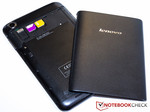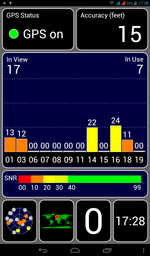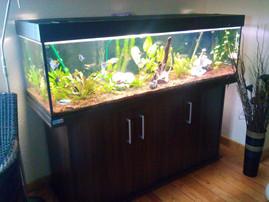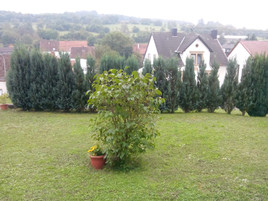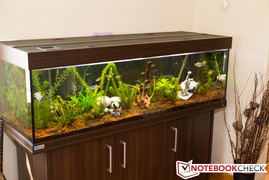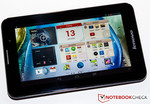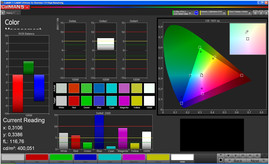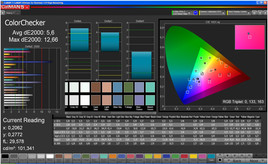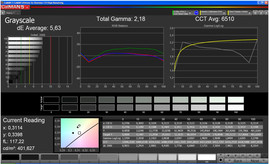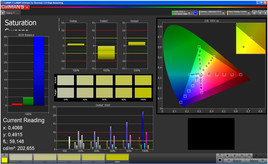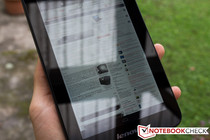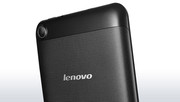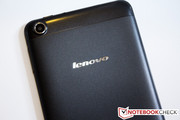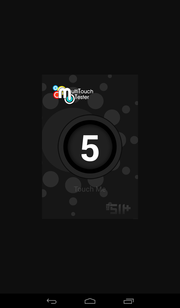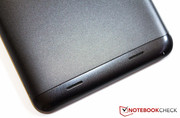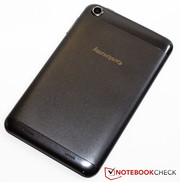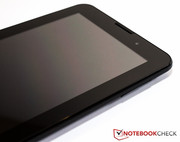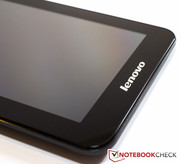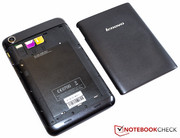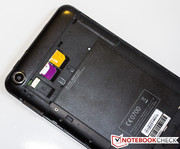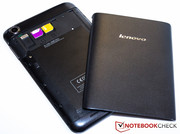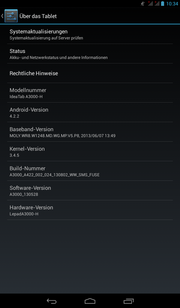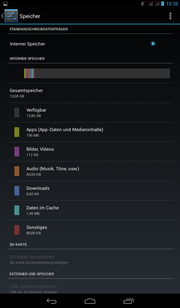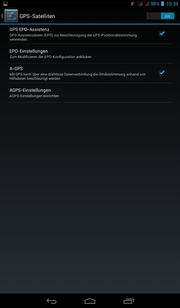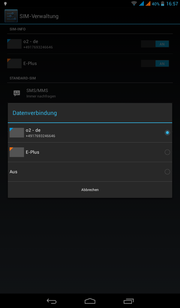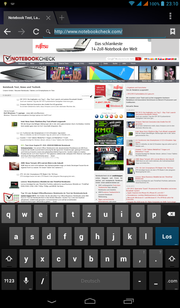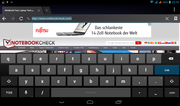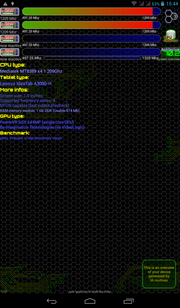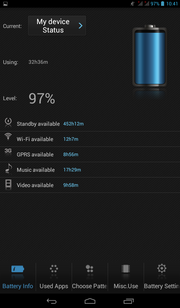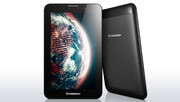Review Lenovo IdeaTab A3000-H Tablet
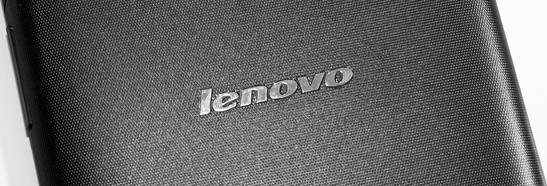
For the original German review, see here.
With the IdeaTab A3000, Lenovo tosses another 7-inch tablet onto the market. We recently thoroughly tested the IdeaTab A1000 (also 7-inches) and found it to be generally unimpressive. The device currently up for review is once again an entry-level model, just like the A1000. The A3000 has a considerably higher recommended retail price (199 Euros, ~$270), but it also received a fairly extensive makeover. For instance, the tablet now has a receiver for wireless internet at UMTS speed and has a quad-core SoC at its command. Lenovo also enhanced the back side of their device with a 5 MP camera.
Are these updates enough to change our overall assessment of the device and convince us to recommend it for purchase? Find out in the following review.
Case
From a distance, the A3000 and the A1000 look very similar -- especially when you look at the front side. If you inspect the two 7-inch devices more closely, you notice a few small differences. For instance, the speaker at the top of the tablet is a little shorter lengthwise. On the back side, however, we see something exceedingly rare in a tablet: The back cover can be completely removed, providing direct access to the battery, micro SD card slot and the two SIM slots. Even though the battery is so easily visible, it's still screwed in and covered with a seal, so it can't be simply removed. Like the whole case, the back cover is made of plastic. All in all, the tablet feels about as stable as the A1000, probably partly because its size is almost identical (194 x 120 x 11 mm; ~7.64 x 4.72 x 0.43 inches). At 339 grams (~0.75 pounds), the A3000 only weighs a tiny bit less. As a result, the two tablets can't be easily distinguished by their size or weight. The A3000's structured and textured battery lid, which stands in contrast to the rest of back case, is the main feature that gives the new device a high-quality look compared to its cheaper counterpart.
Connectivity
In terms of the tablet's external connectivity features, nothing has changed. The audio jack is still on the top of the device, along with the power button and the micro USB port. There are neither keys nor ports on the bottom and left sides of the tablet. The only feature located on the right side is the volume rocker.
The micro SD card slot enables the user to expand on the 16 GB of internal memory. In our IdeaTab A1000 review, we expressed dissatisfaction with the poorly partitioned internal memory -- of the system memory, only 1.49 GB remained open for downloaded apps. Lenovo eliminated this problem in the A3000. The tablet now has only one (visible) partition with 13.08 GB of free space that can be crammed full with apps and games.
Software
The software Lenovo selected for their new device is Google's Android version 4.2 (Jelly Bean). As was true of the IdeaTab S6000 and A1000 we reviewed, the interface is very reminiscent of the barely modified versions that run on the Google Nexus 4, for example. The developers only made minor adaptations to the system settings, just like we saw with the S6000 and A1000.
Communication & GPS
A main feature of the A3000 is its built-in UMTS module with dual SIM function. The two SIM card slots (normal size) are located above the battery and easily accessible via the removable back cover. There is one big difference between the two slots: Slot 1 is capable of establishing a UMTS connection, whereas slot 2 can only make a phone connection. If both SIM cards are installed, in the system settings the user can select which card should be responsible for which function (receiving SMSs, taking calls). Within the user's home network, the tablet generally establishes internet connections via the WLAN module. This module transmits according to the standard 802.11 b/g/n. The reception range is similar to that of the A1000 -- not great. The device can struggle with a connection even when the wireless router is located on the same floor. But this problem isn't as dire as it was with the A1000, since the A3000 switches directly to the cellular network and sustains that connection well. To transmit data over short distances, the A3000 has Bluetooth 4.0 at its command.
Even though we activated the GPS module indoors on a very cloudy day, the module quickly established a connection with enough satellites to determine our location -- with reasonable accuracy. We didn't experience a single unexpected break in the connection at any point in our test.
Cameras & Multimedia
Above the removable back cover, you'll find the 5 MP main camera. The sensor on the front side of the device, however, has a resolution of a meager 0.3 MP and is primarily intended for video calls. Neither camera supports an LED flash.
When capturing images indoors, the main camera's small sensor quickly reaches its limits. As soon as the ambient light grows dim, the pictures instantaneously lose their sharpness. Outdoors the camera's snapshots are much, much better. The level of detail is decent and the colors match those from our reference camera fairly well.
Accessories & Warranty
The packaging contains nothing spectacular. Alongside the tablet, all you'll find is a modular power supply and a paper quick-start guide.
Like the other models, the A3000 has a 12 month warranty for the main device. The battery is under warranty for 6 months.
Input Devices & Operation
When it comes to the tablet's reaction time and display accuracy, we have little to complain about. The only minor issue is the gyro sensor, which ideally would take a little less time to rotate the display image by 90° or 180°. The capacitive display can interpret input from up to five fingers simultaneously.
Display
With the A3000, Lenovo brings a 7-inch tablet to the market that possesses an IPS display with stable viewing angles. Unfortunately, like its cheaper sibling, the display's resolution is still a meager 1024x600 pixels. Using the display size and resolution, we calculate a pixel density of about 170 PPI. To draw a helpful comparison: With the same diagonal display measurements, the current Nexus 7 2013 reaches a pixel density of 323 PPI -- thanks to its Full HD resolution.
At 398 cd/m², the tablet's display's brightest area is in the center of the screen. The average brightness comes to 362.2 cd/m² and is 85% similar across the screen. The display's acceptable black value (0.49 cd/m²) is responsible for the screen's satisfactory contrast of 812:1.
| |||||||||||||||||||||||||
Brightness Distribution: 85 %
Center on Battery: 398 cd/m²
Contrast: 812:1 (Black: 0.49 cd/m²)
ΔE ColorChecker Calman: 5.6 | ∀{0.5-29.43 Ø4.79}
ΔE Greyscale Calman: 5.63 | ∀{0.09-98 Ø5}
Gamma: 2.18
CCT: 6510 K
We used CalMAN 5 software to take a closer look at the display's properties, and discovered that reds and blues are rendered too palely. At 5.6, the average DeltaE 2000 value is too high and is reflected in that some of the colors deviate enough from the ideal that they can also be evaluated as another color. The dark gray tones in the grayscale approach the ideal values, but the lighter the gray, the bigger the DeltaE deviation from the target value.
Because the display's contrast is satisfactory and its average brightness is high, the tablet does well outdoors. As long as the sun's rays aren't directly hitting the screen, the display content is easily visible. This is especially true if you occasionally clean residual fingerprints off the screen and cover it with a matte screen protector.
Thanks to the tablet's IPS display, the screen content is visible and correctly rendered from every viewing angle. Happily, we didn't experience the strange phenomenon that occurred with the A1000. As we tested the earlier tablet, we observed that whether the display image was correctly rendered was dependent not only on the user's vertical viewing angle, but on the horizontal as well.
Performance
A quad-core SoC from Mediatek drives our 7-inch tablet. This inexpensive model is produced using 28 nm process technology and has 1.2 GHz per core at its command. The Mediatek MT8389 works together with a PowerVR GPU and is supported by 1 GB of working memory. The four A7 processor cores are one of our review device's special features, as they are designed to facilitate a healthy compromise between performance and low energy consumption. This SoC was just used in the IdeaTab S6000 we recently reviewed. Its performance is comparable to that of the Nvidia Tegra 3.
As always, using many different benchmarks, we took a closer look at the A3000's performance. We started once again with the synthetic runtime tests. Our test device put up a good show, especially compared with the competition produced by Lenovo. The A1000's SoC doesn't stand a chance, and because of its higher display resolution, the S6000 struggles too. The Asus Memo Pad HD 7 makes a valiant effort, but comes in behind every time -- though just barely.
| Geekbench 2 - 32 Bit - Total Score (sort by value) | |
| Lenovo IdeaTab A3000-H | |
| Lenovo IdeaTab A1000 | |
| Lenovo IdeaTab S6000 | |
| Google Nexus 7 2013 | |
| Asus Memo Pad HD 7 | |
| GFXBench (DX / GLBenchmark) 2.7 | |
| T-Rex Onscreen (sort by value) | |
| Lenovo IdeaTab A3000-H | |
| Lenovo IdeaTab A1000 | |
| Lenovo IdeaTab S6000 | |
| Google Nexus 7 2013 | |
| Asus Memo Pad HD 7 | |
| 1920x1080 T-Rex Offscreen (sort by value) | |
| Lenovo IdeaTab A3000-H | |
| Lenovo IdeaTab S6000 | |
| Google Nexus 7 2013 | |
| Asus Memo Pad HD 7 | |
| 3DMark | |
| 1280x720 Ice Storm Standard Score (sort by value) | |
| Lenovo IdeaTab A3000-H | |
| Lenovo IdeaTab A1000 | |
| Lenovo IdeaTab S6000 | |
| Google Nexus 7 2013 | |
| Asus Memo Pad HD 7 | |
| 1920x1080 Ice Storm Extreme Score (sort by value) | |
| Lenovo IdeaTab A3000-H | |
| Lenovo IdeaTab S6000 | |
| Google Nexus 7 2013 | |
| Asus Memo Pad HD 7 | |
The results in the browser-based benchmarks are a little more disappointing; the A3000 doesn't do quite as well as it did in the previous section. In the Browsermark 2.0 benchmark, for instance, our test device falls behind every one of the competing models, and its result in the Sunspider benchmark is only marginally better.
| Browsermark - --- (sort by value) | |
| Lenovo IdeaTab A3000-H | |
| Lenovo IdeaTab A1000 | |
| Lenovo IdeaTab S6000 | |
| Google Nexus 7 2013 | |
| Asus Memo Pad HD 7 | |
| Apple iPad mini | |
| Sunspider - 1.0 Total Score (sort by value) | |
| Lenovo IdeaTab A3000-H | |
| Lenovo IdeaTab A1000 | |
| Lenovo IdeaTab S6000 | |
| Google Nexus 7 2013 | |
| Asus Memo Pad HD 7 | |
| Google V8 Ver. 7 - Google V8 Ver. 7 Score (sort by value) | |
| Lenovo IdeaTab A3000-H | |
| Lenovo IdeaTab A1000 | |
| Lenovo IdeaTab S6000 | |
| Google Nexus 7 2013 | |
| Asus Memo Pad HD 7 | |
| Apple iPad mini | |
| Peacekeeper - --- (sort by value) | |
| Lenovo IdeaTab A3000-H | |
| Lenovo IdeaTab A1000 | |
| Lenovo IdeaTab S6000 | |
| Google Nexus 7 2013 | |
| Asus Memo Pad HD 7 | |
* ... smaller is better
The A3000's flash memory reads very slowly. All of the competition flies past our review device in this discipline. The memory only scores well during random writing of small files (4 KB). This is the first time our tablet surpasses the new Nexus 7.
Games & Videos
Lenovo also used the quad-core SoC at work in our A3000 in their IdeaTab S6000. In that earlier review, the SoC proved its performance capability and successfully processed all video formats. Now, in the smaller A3000 with weaker resolution, the demands on the processor are even lower. As a result, our review device had no problem running videos. All our Full HD videos could be played on the preinstalled player without any lags or choppy behavior.
We observed the same thing when we ran both 3D and 2D games. The tablet has no problem playing Need for Speed: Hot Pursuit, Modern Combat 4 or the ever-popular Angry Birds Star Wars.
Emissions
Even though our review device's performance is far superior to that of the A1000, it still scores points for remaining at low temperatures under full load. We measured averages of no more than 32.1 °C (89.8 °F) and 33 °C (91.4 °F) under full load (front and back sides respectively). Thanks to its larger case, the 10-inch S6000 tablet keeps itself at even lower temperatures. When the SoC is in idle mode or under very little load, the temperature drops to 28.4 °C (83.1 °F). In both scenarios, our 7-inch tablet remains at a comfortable temperature, and the power supply keeps its cool too.
(+) The maximum temperature on the upper side is 36.3 °C / 97 F, compared to the average of 33.7 °C / 93 F, ranging from 20.7 to 53.2 °C for the class Tablet.
(+) The bottom heats up to a maximum of 37.3 °C / 99 F, compared to the average of 33.2 °C / 92 F
(+) In idle usage, the average temperature for the upper side is 28.4 °C / 83 F, compared to the device average of 30 °C / 86 F.
Speakers
The two built-in speakers reside on the back side of the device and have an extremely high maximum sound pressure level. At only 50% of its maximum volume, the tablet is already louder than some of the competing products. If you want to have a pleasant listening experience, you probably shouldn't turn it up any higher than that. The sound doesn't grow intolerable, but it becomes slightly aggressive and uncomfortable. The high tones slowly go into overdrive and the sound is distorted. If you use the speakers in the appropriate environment, the sound is decent, but it can't compare with external speakers -- as is true of most tablets and smartphones.
Energy Management
Power Consumption
Our review device's energy consumption is comparable with that of the A1000 -- even though it has better hardware. Interestingly, with its 3-inch bigger display, the S6000 needs less energy under both levels of load. Our A3000 uses a battery with a capacity of 3500 mAh (13 Wh). We can assume that this battery is the same one Lenovo installed in the A1000.
| Off / Standby | |
| Idle | |
| Load |
|
Key:
min: | |
Battery Life
When it comes to battery life, our review device leaves something to be desired. At 3 hours and 46 minutes, the runtime under full load is very good, but we expected more in the WLAN test. After just 7 hours and 26 minutes, the tablet needed to be plugged in to an outlet. That's about 90 minutes earlier than the IdeaTab A1000 -- even with the same battery and similar energy consumption rates. Even more disappointing is the amount of time you have between recharges when the processor is idle. At less than 10 hours, our test device can't stand up to the rest of the competition from Lenovo. A full recharge takes 3:18 hours.
Verdict
The IdeaTab A1000 we recently reviewed didn't meet our expectations. It's true that you can't expect wonders from a device with a recommended retail price of 129 Euros (~$175), but there are other tablets in the same price range with better overall performance. With the IdeaTab A3000, Lenovo tries to make corrections for the cheap predecessor's weakness -- by installing a 3G module, for instance. However, the recommended retail price rose to 199 Euros (~$270), and you might question whether the improvements Lenovo made are enough to justify the higher price.
We're very happy about the new quad core SoC; now you can play Full HD videos on the tablet. The 5 MP main camera is another upgrade, though it fails to impress with the photos it captures indoors. We're content with the display, as the IPS panel has good contrast and a high average brightness -- two traits that come together to make the screen easily visible outdoors. The sum of the new features definitely justifies the price jump from the A1000 to our review device. Still, we advise potential buyers to take a look at the other competing models. If you can do without the 3G module, the Asus Memo Pad HD 7 (recommended retail price: 149 Euros, ~$200) is a good option. If you're not rushed for time, it's worth it to take a look at the new Nexus 7.




